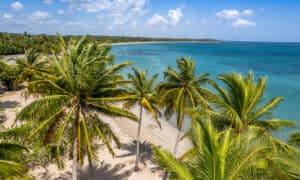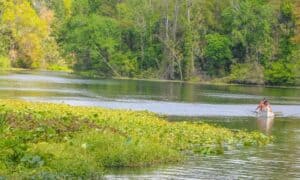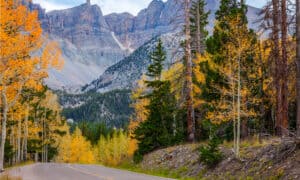Before your next adventure to South America, there are a few places you should consider visiting. In Peru, there are numerous national parks that are stunning beyond belief. If you wish to experience new outdoor excursions, diverse wildlife, and superb scenery, these Peruvian national parks should be at the top of your to-do list. This article will introduce and describe 4 beautiful national parks in Peru, what activities there are to do there, and what animals to look out for.
History and Geography
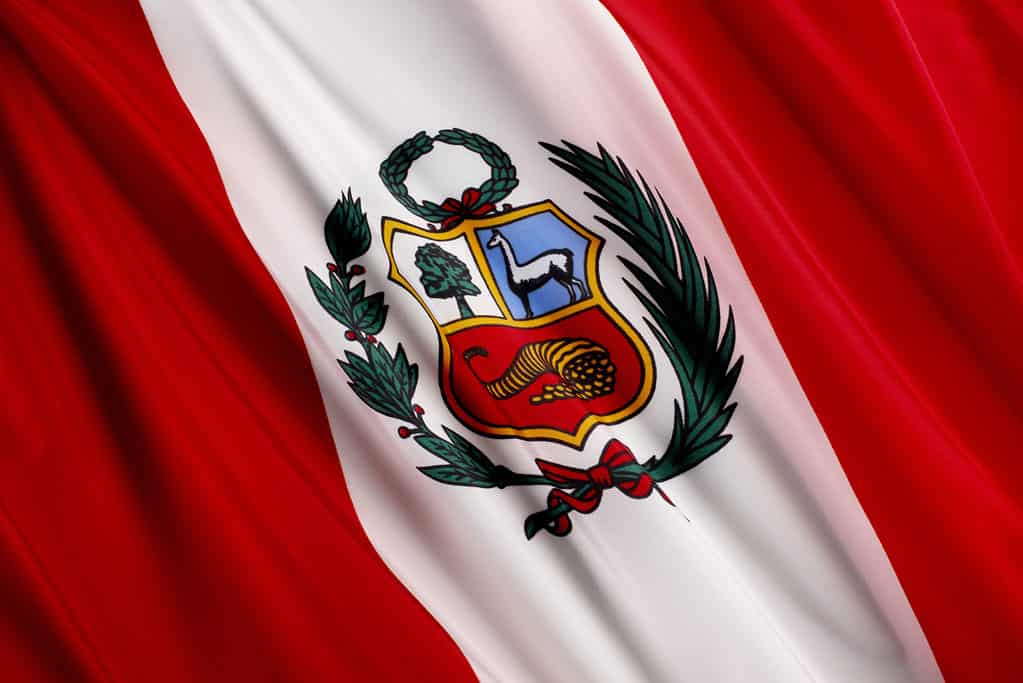
The Peruvian flag features the vicuña, an animal closely related to llamas and alpacas.
©Jim Barber/Shutterstock.com
Peru is located just south of the equator, partially in the Amazon Basin, and its western border is on the Pacific coast of South America. It is dense with terrestrial, aquatic, and avian life and supports this biodiversity in many different types of habitats. Peru has the second most diverse avian community in the world after Colombia. It is also considered to be amongst the 17 most biodiverse countries in the world. In fact, the Peruvian Amazon is considered one of the most pristine, untouched environments remaining on Earth. To preserve this incredible nature, Peru has many protected natural areas including 12 national parks. The first national park, Cutervo, was created in 1961, and the most recently declared national park was Yaguas in 2018.
Conservation efforts throughout Peruvian history are not limited to national park protection. Other types of areas that receive different levels of protection are national reserves, national sanctuaries, wildlife refuges, landscape reserves, community reserves, protected forests, enclosed hunting zones, and reserved zones. In total, Peru has 75 protected areas. These classifications all entail rules of varying rigidity in how the land and resources can be used. Community reserves, for example, allow local populations to take resources from the protected areas for traditional uses.
1. Manú National Park and Biosphere Reserve
Manú National Park is in the Madre de Dios and Cusco regions of Peru. It became a national park in 1973 and later was designated a Biosphere Reserve and a World Heritage Site by UNESCO. The park encompasses an area of 17,163 km2 that features mountainous terrain, lowland rainforests, cloud forests, and a portion of the Amazon Basin plains. When you visit, there are five areas open to tourists. There, you can enjoy the great flora and fauna from paths and along rivers. There are viewing points, campsites, lodges, and a canopy walkway, as well.

Jaguars are among the many predatory species in Peru that live throughout Manú National Park.
©Pedro Helder Pinheiro/Shutterstock.com
Over 160 mammal species have been reported in the park including jaguars, giant armadillos, giant anteaters, various marmosets and tamarins, capuchin monkeys, spider monkeys, South American tapirs, and spectacled bears, to name a few. The park hosts more than 1000 bird species such as Amazonian pygmy owls, Andean condors, giant hummingbirds, blue-and-yellow macaws, scarlet macaws, harpy eagles, and king vultures. There are also 132 species of reptiles, like spectacled caimans, black caimans, boas, and green anacondas. Park residents also include 155 amphibian species including many different frogs, toads, and caecilians. Scientific research with focuses on topics of ecology, biology, and conservation exists within the park and there are also research centers in the surrounding area.
2. Huascarán National Park
Huascarán National Park is a 3,400 km2 area that is home to the highest tropical mountain range in the world, the Cordillera Blanca. The tallest peak in the Cordillera Blanca range is Mount Huascarán, for which the park earns its name. The varying landscapes also boast tropical glaciers, glacial lakes, ravines, high Andean forests, and montane grasslands. This topography makes Huascarán National Park an adventurer’s paradise. There are plenty of opportunities for mountaineering, climbing, hiking, backpacking, mountain biking, and skiing. You can also enjoy cultural tourism and visit one of the 33 archaeological sites in the park. These sites have cave paintings, ancient settlements, tombs, and other prehistoric structures.

The very large Queen of the Andes plant can be found at Huascarán National Park, Peru.
©Christian Vinces/Shutterstock.com
While you trek through the park you will surely see incredible plant and animal life. One of the most important plants in the country from both cultural and conservational perspectives is the Queen of the Andes. This plant is the largest of the bromeliads – the family that includes pineapples – and stands up to 50 feet tall. The park is also home to more than 10 mammal species including the colocolo or Pampas cat, the Andean mountain cat, the puma, and the spectacled bear. More than 120 bird species coexist in the park, as well.
3. Cerros de Amotape National Park
Cerros de Amotape National Park is a vast protected land of 1,516 km2 located in the Piura and Tumbes regions of Peru. It earned its status as a national park in 1975. In the park, variable terrain includes the Cordillera de los Amotapes mountain range, the Tumbes River, a portion of the Tumbes-Piura dry forests ecoregion, and part of the Pacific Tropical Forest. Visitors have plenty to explore and enjoy in the park such as hiking, nature watching, and canoeing in the Tumbes River. There are overnight facilities at the park’s checkpoints and the research facilities in the park welcome visitors, as well.
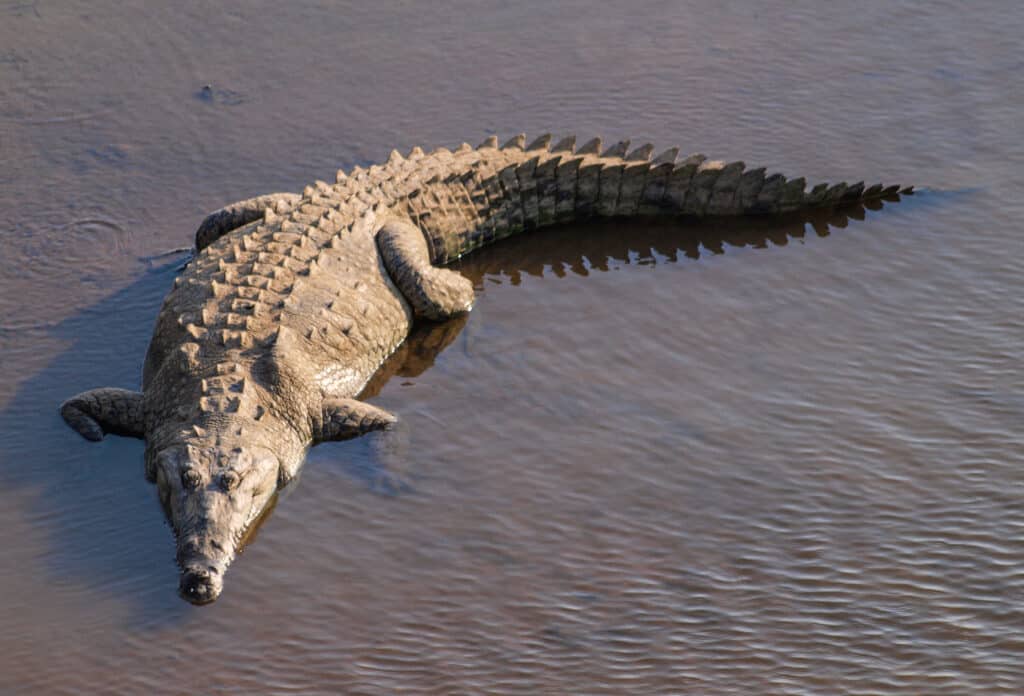
The American crocodile is currently a vulnerable species but populations are increasing due to conservation efforts.
©iStock.com/CStorz
Many animals call Cerros de Amotape National Park home. The Guayaquil squirrel is a large squirrel species endemic to Peru and Ecuador. That means that it only exists in these two places. Other mammals of the park are red brockets, white-tailed deer, mantled howler monkeys, white-fronted capuchins, ocelots, and jaguars. There are 111 bird species in the park including the grey-backed hawk, the grey-cheeked parakeet, and the slaty becard. The endangered American crocodile also dwells in Cerros de Amotape National Park.
4. Yanachaga-Chemillén National Park
The beautiful Yanachaga-Chemillén National Park encompasses rainforests and cloud forests in the central Peruvian region of Pasco. This park extends across an area of 1,220 km2 and is primarily carpeted in forests. It is an extremely biodiverse location on the eastern side of the Andes stretching to the Amazon Basin. The national park protects the Palcazu, Huancabamba, and Pozuzo rivers that are all tributaries to the Amazon River. If you plan to visit Yanachaga-Chemillén National Park, the easiest point of access is from the town of Oxapampa. In the park, you can view wildlife, interact with indigenous communities within the park, and visit archaeological sites from the Inca and Yanesha cultures.

The Andean cock-of-the-rock is the national bird of Peru.
©David Havel/Shutterstock.com
Yanachaga-Chemillén National Park is home to a plethora of avian, mammalian, reptilian, and amphibian life. Interestingly, this park is the only known area with populations of Ctenophryne barbatula, a frog endemic to Peru. Mammal species include the capybara, the jaguar, the puma, the spectacled bear, and the Jaguarundi, amongst many others. Impressively, there are 550 bird species in this park including most notably harpy eagles, Andean cock-of-the-rocks, blue-crowned motmots, quetzals, toucans, hoatzins, Amazonian umbrellabirds, and blue-grey tanagers.
The photo featured at the top of this post is © iStock.com/Patryk_Kosmider
Thank you for reading! Have some feedback for us? Contact the AZ Animals editorial team.



